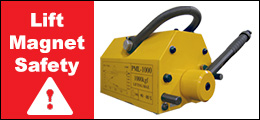 Lift magnets have been a part of material handling in American manufacturing for over 75 years. Most common are mechanically operated magnets that switch “on” or “off” by physically changing the Polarity of the lifting magnets. This is done by the operating of a handle on the magnet casing. These require no outside power source to generate the magnetic field. They are known as “permanent magnets”. These magnets are not to be confused with electromagnets which use electric power to create their lifting energy. The American Society of manufacturing engineers has established compliance standards for use of these magnets under ASME B.30.20-3 .
Lift magnets have been a part of material handling in American manufacturing for over 75 years. Most common are mechanically operated magnets that switch “on” or “off” by physically changing the Polarity of the lifting magnets. This is done by the operating of a handle on the magnet casing. These require no outside power source to generate the magnetic field. They are known as “permanent magnets”. These magnets are not to be confused with electromagnets which use electric power to create their lifting energy. The American Society of manufacturing engineers has established compliance standards for use of these magnets under ASME B.30.20-3 .
New developments in magnet technology and specifically the use of rare earth materials have made these tools for material handling more effective. With these more powerful magnets, adherence to safe practices when using them is more important than ever.
General ASME Standard
To be compliant to the ASME standard these general guidelines always apply.
- Operators must read and understand all instructions before operating a lifting magnet
- Operator must know the magnet capacity required for the material thickness being lifted
- Use no magnet not marked with a load rating or safety placard
- Treat magnets as if they are always on; loose metal, tools, cell phones, steel parts may be violently pulled to a magnet without warning causing serious injury.
- NEVER stand or place any part of your body under a load or in the path of a moving load.
- Strong magnets affect electronic devices from computers to pacemakers
Top Questions to ask before using a lift magnet to insure proper operation and performance
Magnets work best in certain conditions and varying from that can cause big drops in lifting strength. So make sure to ask these questions before operating the lift magnet.
- What is the material composed of? It is Important to remember that alloys may not be as magnetic as low carbon steel. So make sure that the material is steel.
- What is the surface of the material like? There should not be any waves, bows, or gaps on the lifting surface and needs to be as flat as possible. Round stock lifts at a lower capacity due to less contact area.
- What is the condition of the materials surface? The surface should always be clean dry and free of oil, dirt, rust, or contaminants
- What is the weight of the material being lifted? Make sure to know the weight of the lifted load. The weight of a steel object is Length (in.) X width (in.) X thickness (in.) X .283
- Is the material thick or thin? It’s harder to pick up thin vs thick when it comes to a magnet. A magnet may pick up a 3 inch thick block weighing 500 lbs but not lift a sheet less than an inch thick weighing less.
- What is the temperature of the material? permanent lifting magnets break down at temperatures approaching 200 degrees F.
Knowing specific guidelines for the safe use, evaluation, and operation of these magnets is very important. Make sure your employees and yourself are aware of even these basic guidelines. If looking to purchase or learn more about lifting magnets click here.
